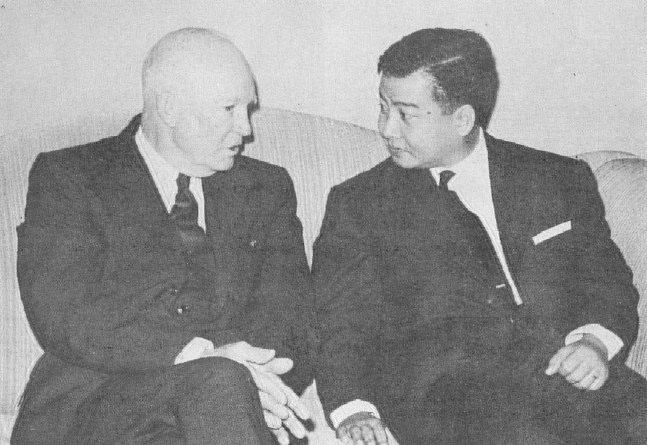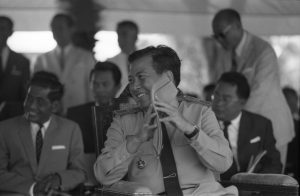According to historian Walter LaFeber, U.S. President Dwight D. Eisenhower (in office 1953-1961) believed that “the overriding threat to world stability was communism, not starvation, inequality, or other wants that led the have-nots to rebel against the haves.” To thwart this global threat, Eisenhower established a post-World War II strategic presence for the United States in Asia, whereby a cost-effective yet enduring U.S. regional framework was bolstered by trained and armed allies to serve as a deterrent to the People’s Republic of China. Known as the Mutual Security Program, it provided a key complementary piece to Eisenhower’s “New Look” nuclear deterrence strategy.
The role of intelligence – seen as a low-cost, reduced-risk alternative to the potential introduction of U.S. armed forces – was also of paramount importance to Eisenhower. The Central Intelligence Agency (CIA) saw several “successes” during Eisenhower’s two terms in office, notably in Iran and Guatemala, where the democratically elected left-leaning prime minister and president, respectively, were overthrown in U.S.-supported coups d’état.
Not all interventions saw success, however. Sixty-five years ago, the People’s Republic of China crushed Tibetan resistance fighters despite the CIA’s support for the uprising. In Cambodia, an oft-overlooked attempt to overthrow Cold War neutralist Prince Norodom Sihanouk was thwarted as well. The aftershocks of the Eisenhower strategy can be seen in the Cambodia example, a classic case of Cold War hubris on the part of the U.S., in which a poorly supported and executed plan went awry, and pushed Cambodia closer to the perceived enemies of the United States.
French officials selected Sihanouk, who was seen as a potentially pliable monarch, to succeed King Monivong. Coronated on May 3, 1941, the wide-eyed 18-year-old soon found his country occupied by Japanese forces. After nationalist Son Ngoc Thanh briefly led an independent Cambodia as prime minister as World War II ended, French forces returned to reestablish their protectorate. Sihanouk steered years of incremental steps toward freedom (spurred on by conservative anti-monarch dissident followers of Son Ngoc Thanh, which coalesced in the Khmer Issarak). Eventually Cambodia won its independence in November 1953.
Son Ngoc Thanh refused to join the new government, however. In June 1954 the CIA reported that “there are also in Cambodia several hundred armed non-Communist dissidents, who are followers of the nationalist leader, Son Ngoc Thanh.”
Following the Geneva Conference and Cambodia’s independence, Sihanouk was more popular than ever. Buoyed by his success in ousting the French, he set out to marginalize political opponents, especially those close to Thanh. When Sihanouk abdicated the throne in March 1955 and formed the Sangkum (People’s) Party in an effort to consolidate political power, Cambodia’s neighbors to the east and west, South Vietnam and Thailand, respectively, supported dissident conservative forces, notably Son Ngoc Thanh.
While some American diplomats stationed in embassies in Saigon and Bangkok discouraged this, U.S. intelligence, concerned with Sihanouk’s diplomatic overtures to communist nations, generally encouraged it. The CIA’s Deputy Director Robert Amory stated, following Sihanouk’s abdication, “That dirty rat, my King has run out on me.”
This incongruous policy toward Cambodia helped to bolster Thanh’s aspirations and would work to isolate Cambodia from both its neighbors and the United States. This culminated in a historically overlooked coup attempt in 1959 that resulted in both further strained relations between the U.S. and Cambodia and a hardened, empowered, and defiant Norodom Sihanouk.
Contributing to Cambodia’s uncertain political future was the fact that the political infrastructure still existed for communism to emerge as the dominant force in the country, despite the fact that the Viet Minh had removed the majority of its ground forces following the Geneva Conference. U.S. Army intelligence was concerned that the few remaining Issarak rebels in Cambodia were susceptible to communist influence due to their “venal nature.”
Son Ngoc Thanh was again singled out as a potential problem. If he were to join with the communists, it “could create a situation whose suppression could be difficult for the Cambodian army.” It was this fear, along with Sihanouk’s overtures to the political left in his country, that caused a shift in U.S. policy toward Thanh.
In some ways this shift made sense, at least on the surface. Sihanouk’s neutrality caused suspicion in both Thailand and South Vietnam, as Cambodia’s neighbors grew paranoid in the face of what they perceived to be communist aggression. It was Zhou Enlai’s personal approach at the Bandung Conference in April 1955 that planted the seeds for Sihanouk’s political shift. When Sihanouk turned down a Philippine effort to secure Cambodian entry into the U.S.-led South-East Asia Treaty Organization the following February and accepted $22.4 million in Chinese aid soon after, his neighbors took notice.
Meanwhile, those who felt the brunt of Sihanouk’s oppressive wrath during the election season of 1955, predominantly members of the Democratic Party and their supporters, saw little future for themselves in Cambodian politics. Many fled to the former Issarak stronghold in the northwest and joined Son Ngoc Thanh, although this motley crew was far from the relative powerhouse of the Issaraks of years prior. They needed external support for their crusade against the prince. Luckily a receptive partner was a stone’s throw across the border. Together, they would attempt to destabilize Cambodia in the most subversive fashion, through a coup.
U.S. officials were aware of the potential for a coup to occur in Cambodia, as Alfred Jenkins, deputy director of the Office of Southeast Asian Affairs, noted in a memo to Assistant Secretary of State for Far Eastern Affairs Walter Robertson on August 21, 1958. If one were to occur, Thanh was seen as a possible candidate to lead an overthrow of Sihanouk.

U.S. President Dwight Eisenhower (left) and Prince Norodom Sihanouk of Cambodia in 1959. Photo via the U.S. Embassy, Phnom Penh.
The end of the decade culminated in a series of plots against Sihanouk. Generally referred to as the Sam Sary-led “Bangkok Plot” or the Dap Chhuon Affair, they marked a turning point in how Sihanouk viewed his neutral position in the Cold War, as he now found himself surrounded by Western-aligned enemies. The end of the 1950s also signified a shift in how the South Vietnamese and Thai governments viewed Cambodian neutrality (or in their minds, left-leaning neutrality). Communist subversion, according to Saigon and Bangkok, could not effectively be fought with Sihanouk in power. He had to be replaced with a like-minded “cold warrior.”
Son Ngoc Thanh was to play an integral part in these developments. It was also this period that saw the U.S. become associated with subversive activities plotted against Sihanouk. In doing so, the Americans became linked with Son Ngoc Thanh, among others. This link was to last until the fall of the Khmer Republic in 1975.
In late 1958, Sam Sary, an ostracized Cambodian politician, met with Thai and South Vietnamese officials, Son Ngoc Thanh, and CIA officials. At this meeting the secret bilateral committee made the decision to overthrow the prince. These representatives from Western-aligned groups and countries would theoretically, if successful, steer Cambodia in a more U.S.-friendly direction.
According to the plan, Thanh would establish a base on the Thai-Cambodian border, and ethnic Khmer would be recruited from South Vietnam on the eastern Cambodian border. Dap Chhuon, an ardent anti-communist and former Issarak who had previously rallied to the prince and been appointed as governor of Siem Reap province in the northwest of Cambodia, and Sam Sary would organize an uprising within Cambodia itself. Thai premier Marshal Sarit Thanarat provided support and CIA agent Victor Matsui would coordinate all contacts.
While there remains much to uncover with respect to the Dap Chhuon plot of 1959, the basics of how events eventually unfolded are generally agreed upon. Eisenhower was informed of the plot as early as November 5, 1958. By January the CIA had confirmed both Saigon’s and Bangkok’s participation as well as the name of the principal instigator, Dap Chhuon. Khmer Serei (Free Khmer) and Khmer Krom, who would later be explicitly tied to both U.S. intelligence and U.S. special forces, were to provide martial support for the coup.
After being tipped off by various sources, including the French and the communists, Sihanouk’s troops, led by Lon Nol, moved in on Dap Chhuon’s stronghold of Siem Reap on February 21 and easily squashed the coup attempt before it had a chance to get off the ground. Chhuon was killed while allegedly attempting to escape, and in addition to a cache of arms, money, and gold, a CIA radio was found. While the State Department denied a U.S. role, it did acknowledge to its British counterpart that the Saigon and Bangkok governments were “deeply involved.”
In a speech, Sihanouk described the plot as “drawn up by a marshal, head of the government of a neighboring kingdom, by the envoys of a neighboring state, and by Son Ngoc Thanh. Like nocturnal birds of prey blinded by the hunter’s torch, dark schemes hatched in secret will come to nothing once they are dragged out into the light.”
The truth may have been revealed years later, in a telephone conversation between President John F. Kennedy and Assistant Secretary of State for Far Eastern Affairs Roger Hilsman. In perhaps the most glaring example of the chasm that existed at times between different segments of the grand foreign policy apparatus of the U.S., Kennedy himself was apparently unaware of the prior CIA involvement in Cambodia.

U.S. President John F. Kennedy (right) holds a small statue presented by Prince Norodom Sihanouk of Cambodia (center) in the President’s Suite at the Carlyle Hotel, New York City, New York, Sep. 25, 1961. Photo via John F. Kennedy Presidential Library and Museum.
In a November 20, 1963, discussion of Sihanouk’s cutting off of American aid, Hilsman stated that it was due to the continued antagonism of the Khmer Serei and fear of assassination. “There’s a history, during the administration of President Eisenhower, where the agency [CIA] did play footsie with opposition groups,” Hilsman informed Kennedy.
“Was that a true story about the ’59 or something?” Kennedy, in apparent reference to Dap Chhuon’s failed coup attempt, asked.
Hilsman responded, “Yes sir, it is true.”
“CIA did do it?” inquired the president.
“Sure. They supplied some money, and, uh, they were involved in a plot against Sihanouk back before this administration,” replied Hilsman. He went on: “The agency in those days wasn’t responsible to the State Department. They [the CIA] did things they [State] probably didn’t know about.”
Although some details remain murky, the U.S. was certainly involved in the Dap Chhuon Affair. The above conversation also highlights the seeming disconnect between members of the traditional diplomatic corps, be they ambassadors, embassy staff, or the State Department, and that of the intelligence community. Sihanouk’s own memoirs are titled “My War With the CIA” for this very reason.
Cambodia in 1959 was, in many ways, symptomatic of the trappings of such a policy. It was from this point that future problems between the two countries began to take root. And there was more to come. By 1963 Sihanouk had rejected American military aid. In 1965, he broke diplomatic relations with the United States. And in 1970, he was finally removed from office through a coup that the U.S., again, was likely involved in. What followed was five years of civil war and then, beginning in April 1975, three years, eight months, and 20 days of torture for Cambodia’s people under the Khmer Rouge.

































